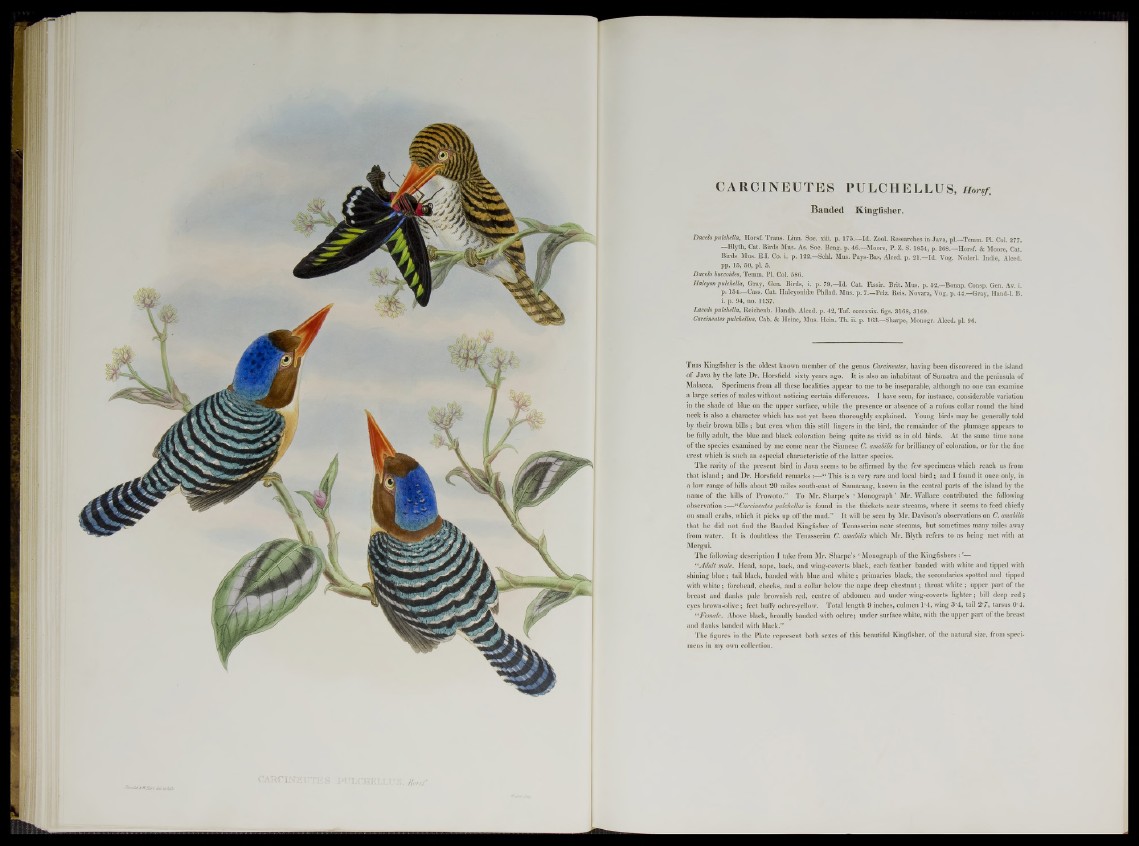
CARCINEUTES PULCHELLUS, Horsf.
Banded Kingfisher.
Dacelo pulchella, Horsf. Trans. Linn. Soc. xiii. p. 175.— Id. Zool. Researches in Java, pi.—Temm. PI. Col. 277.
—Blyth, Cat. Birds Mus. As. Soc. Beng. p. 46.—Moore, P. Z. S. 1854, p. 268.—Horsf. & Moore, Cat.
Birds Mus. E.I. Co. i. p. 122.—Schl. Mus. Pays-Bas, Alced. p. 21.—Id. Yog. Nederl. Indie, Alced.
pp. 15, 50, pi. 5.
Dacelo buccoides, Temm. PI. Col. 586.
Halcyon pulchella, Gray, Gen. Birds, i. p. 79.—Id. Cat. Fissir. Brit. Mus. p. 52.—Bonap. Consp. Gen. Av. i.
p. 154.—Cass. Cat. Halcyonidas Philad. Mus. p. 7—Pelz. Reis. Novara, Vog. p . 4 4—Gray, Hand-1. B.
i. p. 94, no. 1137.
Lacedo pulchella, Reichenb. Handb. Alced. p. 42, Taf. ccccxxix. figs. 3168, 3169.
Carcineutes pulchellus. Cab. & Heine, Mus. Hein. Th. ii. p. 163.—Sharpe, Monogr. Alced. pi. 96.
T h is Kingfisher is the oldest known member of the genus Carcineutes, having been discovered in the island
of Java by the late Dr. Horsfield sixty years ago. It is also an inhabitant of Sumatra and the peninsula of
Malacca. Specimens from all these localities appear to me to be inseparable, although no one can examine
a large series of males without noticing certain differences. I have seen, for instance, considerable variation
in the shade of blue on the upper surface, while the presence or absence of a rufous collar round the hind
neck is also a character which has not yet been thoroughly explained. Young birds may be generally told
by their brown bills ; but even when this still lingers in the bird, the remainder of the plumage appears to
be fully adult, the blue and black coloration being quite as vivid as in old birds. At the same time none
of the species examined by me come near the Siamese C. amabilis for brilliancy of coloration, or for the fine
crest which is such an especial characteristic of the latter species.
The rarity of the present bird in Java seems to be affirmed by the few specimens which reach us from
that island; and Dr. Horsfield remarks :—“ This is a very rare and local bird j and I found it once only, in
a low range of hills about 20 miles south-east of Samarang, known in the central parts of the island by the
name of the hills of Prowoto.” To Mr. Sharpe’s ‘ Monograph ’ Mr. Wallace contributed the following
observation :— “Carcineutes pulchellus is found in the thickets near streams, where it seems to feed chiefly
on small crabs, which it picks up off the mud.” It will be seen by Mr. Davison’s observations on C. amabilis
that he did not find the Banded Kingfisher of Tenasserim near streams, but sometimes many miles away
from water. It is doubtless the Tenasserim C. amabilis which Mr. Blyth refers to as being met with at
Mergui.
The following description I take from Mr. Sharpe’s ‘ Monograph of the Kingfishers:
“Adult male. Head, nape, back, and wing-coverts black, each feather banded with white and tipped with
shining blue; tail black, banded with blue and white ; primaries black, the secondaries spotted and tipped
with white; forehead, cheeks, and a collar below the nape deep chestnut; throat white ; upper part of the
breast and flanks pale brownish red, centre of abdomen and under wing-coverts lighter; bill deep red;
eyes brown-olive; feet buffy ochre-yellow. Total length 9 inches, culmen 1'4, wing 3’4, tail 2'7, tarsus 0‘4.
“Female. Above black, broadly banded with ochre; under surface white, with the upper part of the breast
and flanks banded with black.”
The figures in the Plate represent both sexes of this beautiful Kingfisher, of the natural size, from specimens
in my own collection.